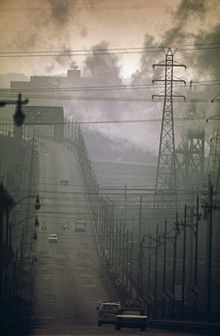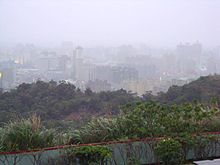Air pollution has always accompanied civilizations. Pollution started from prehistoric times, when man created the first fires. According to a 1983 article in the journal Science, "soot" found on ceilings of prehistoric caves provides ample evidence of the high levels of pollution that was associated with inadequate ventilation of open fires."[4] Metal forging appears to be a key turning point in the creation of significant air pollution levels outside the home. Core samples of glaciers in Greenland indicate increases in pollution associated with Greek, Roman, and Chinese metal production.[5]
Urban pollution
The burning of coal and wood, and the presence of many horses in concentrated areas made the cities the primary sources of pollution. The Industrial Revolution brought an infusion of untreated chemicals and wastes into local streams that served as the water supply. King Edward I of England banned the burning of sea-coal by proclamation in London in 1272, after its smoke became a problem;[6][7] the fuel was so common in England that this earliest of names for it was acquired because it could be carted away from some shores by the wheelbarrow.
It was the industrial revolution that gave birth to environmental pollution as we know it today. London also recorded one of the earlier extreme cases of water quality problems with the Great Stink on the Thames of 1858, which led to construction of the London sewerage system soon afterward. Pollution issues escalated as population growth far exceeded viability of neighborhoods to handle their waste problem. Reformers began to demand sewer systems and clean water.[8]
In 1870, the sanitary conditions in Berlin were among the worst in Europe. August Bebel recalled conditions before a modern sewer system was built in the late 1870s:
- "Waste-water from the houses collected in the gutters running alongside the curbs and emitted a truly fearsome smell. There were no public toilets in the streets or squares. Visitors, especially women, often became desperate when nature called. In the public buildings the sanitary facilities were unbelievably primitive....As a metropolis, Berlin did not emerge from a state of barbarism into civilization until after 1870."[9]
The primitive conditions were intolerable for a world national capital, and the Imperial German government brought in its scientists, engineers, and urban planners to not only solve the deficiencies, but to forge Berlin as the world's model city. A British expert in 1906 concluded that Berlin represented "the most complete application of science, order and method of public life," adding "it is a marvel of civic administration, the most modern and most perfectly organized city that there is."[10]
The emergence of great factories and consumption of immense quantities of coal gave rise to unprecedented air pollution and the large volume of industrial chemical discharges added to the growing load of untreated human waste. Chicago and Cincinnati were the first two American cities to enact laws ensuring cleaner air in 1881. Pollution became a major issue in the United States in the early twentieth century, as progressive reformers took issue with air pollution caused by coal burning, water pollution caused by bad sanitation, and street pollution caused by the 3 million horses who worked in American cities in 1900, generating large quantities of urine and manure. As historian Martin Melosi notes, The generation that first saw automobiles replacing the horses saw cars as "miracles of cleanliness.".[11] By the 1940s, however, automobile-caused smog was a major issue in Los Angeles.[12]
Other cities followed around the country until early in the 20th century, when the short lived Office of Air Pollution was created under the Department of the Interior. Extreme smog events were experienced by the cities of Los Angeles and Donora, Pennsylvania in the late 1940s, serving as another public reminder.[13]
Air pollution would continue to be a problem in England, especially later during the industrial revolution, and extending into the recent past with the Great Smog of 1952. Awareness of atmospheric pollution spread widely after World War II, with fears triggered by reports of radioactive fallout from atomic warfare and testing.[14]Then a non-nuclear event—the Great Smog of 1952 in London—killed at least 4000 people.[15] This prompted some of the first major modern environmental legislation: the Clean Air Act of 1956.
Pollution began to draw major public attention in the United States between the mid-1950s and early 1970s, when Congress passed the Noise Control Act, the Clean Air Act, the Clean Water Act, and the National Environmental Policy Act.[16]
Severe incidents of pollution helped increase consciousness. PCB dumping in the Hudson River resulted in a ban by the EPA on consumption of its fish in 1974. National news stories in the late 1970s—especially the long-term dioxin contamination at Love Canal starting in 1947 and uncontrolled dumping in Valley of the Drums—led to the Superfund legislation of 1980.[17]The pollution of industrial land gave rise to the name brownfield, a term now common in city planning.
The development of nuclear science introduced radioactive contamination, which can remain lethally radioactive for hundreds of thousands of years. Lake Karachay—named by the Worldwatch Institute as the "most polluted spot" on earth—served as a disposal site for the Soviet Union throughout the 1950s and 1960s. Chelyabinsk, Russia, is considered the "Most polluted place on the planet".[18]
Nuclear weapons continued to be tested in the Cold War, especially in the earlier stages of their development. The toll on the worst-affected populations and the growth since then in understanding about the critical threat to human health posed by radioactivity has also been a prohibitive complication associated with nuclear power. Though extreme care is practiced in that industry, the potential for disaster suggested by incidents such as those at Three Mile Island and Chernobyl pose a lingering specter of public mistrust. Worldwide publicity has been intense on those disasters.[19] Widespread support for test ban treaties has ended almost all nuclear testing in the atmosphere.[20]
International catastrophes such as the wreck of the Amoco Cadiz oil tanker off the coast of Brittany in 1978 and the Bhopal disaster in 1984 have demonstrated the universality of such events and the scale on which efforts to address them needed to engage. The borderless nature of atmosphere and oceans inevitably resulted in the implication of pollution on a planetary level with the issue of global warming. Most recently the term persistent organic pollutant (POP) has come to describe a group of chemicals such as PBDEs and PFCs among others. Though their effects remain somewhat less well understood owing to a lack of experimental data, they have been detected in various ecological habitats far removed from industrial activity such as the Arctic, demonstrating diffusion and bioaccumulation after only a relatively brief period of widespread use.
A much more recently discovered problem is the Great Pacific Garbage Patch, a huge concentration of plastics, chemical sludge and other debris which has been collected into a large area of the Pacific Ocean by the North Pacific Gyre. This is a less well known pollution problem than the others described above, but nonetheless has multiple and serious consequences such as increasing wildlife mortality, the spread of invasive species and human ingestion of toxic chemicals. Organizations such as 5 Gyres have researched the pollution and, along with artists like Marina DeBris, are working toward publicizing the issue.
Pollution introduced by light at night is becoming a global problem, more severe in urban centres, but nonetheless contaminating also large territories, far away from towns.[21]
Growing evidence of local and global pollution and an increasingly informed public over time have given rise to environmentalism and the environmental movement, which generally seek to limit human impact on the environment.



Comments
Post a Comment